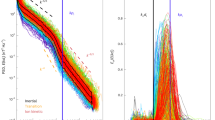The dynamics of an intense rising convective jet in the atmosphere has been investigated numerically and analytically. Primary consideration has been given to the interaction of the jet with stably stratified “retarding layers.” The possible influence of radiation effects — heat release associated with the absorption of the shortwave solar radiation by the carbon black contained in the jet — on the jet dynamics has been considered. The above black is generated by the fuel combustion in the “meteotron,” and can also be introduced additionally into the jet to intensify it. It has been shown that the radiation effects can, in principle, contribute greatly to the jet rise.
Similar content being viewed by others
References
N. I. Vul’fson and L. M. Levin, Meteotron as a Means of Influencing the Atmosphere [in Russian], Gidrometeoizdat, Moscow (1987).
L. G. Kachurin, Physical Principles of Acting on Atmospheric Processes [in Russian], Gidrometeoizdat, Leningrad (1990).
H. Dessens and J. Dessens, Experiences avec le meteotron un Centre de Recherches Atmospheriques, J. Rech. Atm., 1, 158–162 (1965).
J. S. Turner, Buoyancy Effects in Fluids [Russian translation], Mir, Moscow (1977).
B. Gebhart, J. Jaluria, R. L. Mahajan, and B. Sammaki, Buoyancy-Induced Flows and Transport [Russian translation], Vol. 2, Mir, Moscow (1991).
R. S. Scorer, Environmental Aerohydrodynamics [Russian translation], Mir, Moscow (1980).
W. M. Gray, W. M. Frank, M. L. Corrin, and C. A. Stokes, Weather modification by carbon dust absorption of solar energy, J. Appl. Meteorol., 15, No. 4, 355–386 (1976).
C. S. Chen and H. D. Orville, The effects of carbon black dust on cumulus-scale convection, J. Appl. Meteorol., 16, No. 4, 401–412 (1977).
L. Kh. Ingel’, Effects of air-scattered carbon dust (black) absorption of solar energy on atmospheric processes, in: Active Influences on Hydrometeorological Processes, Proc. All-Union Conf., Kiev, November, 1987, Gidrometeoizdat, Leningrad (1990). pp. 444–450.
L. Kh. Ingel’, Hydrothermodynamic Effects of a Heat-Releasing Impurity and of Other Volume Heat Sources in the Atmosphere (Theory), Doctoral Dissertation (in Physics and Mathematics), Obninsk (1996).
L. F. Radke, J. H. Lyons, P. S. Hobbs, and R. E. Weiss, Smokes from the burning of aviation fuel and their self-lofting by solar heating, J. Geophys. Res., 95, No. D9, 14071–14076 (1990).
Author information
Authors and Affiliations
Corresponding author
Additional information
Translated from Inzhenerno-Fizicheskii Zhurnal, Vol. 83, No. 1, pp. 111–117, January–February, 2010.
Rights and permissions
About this article
Cite this article
Ingel’, L.K. Radiation amplification of the meteotron effect. J Eng Phys Thermophy 83, 122–129 (2010). https://doi.org/10.1007/s10891-010-0326-2
Received:
Revised:
Published:
Issue Date:
DOI: https://doi.org/10.1007/s10891-010-0326-2




